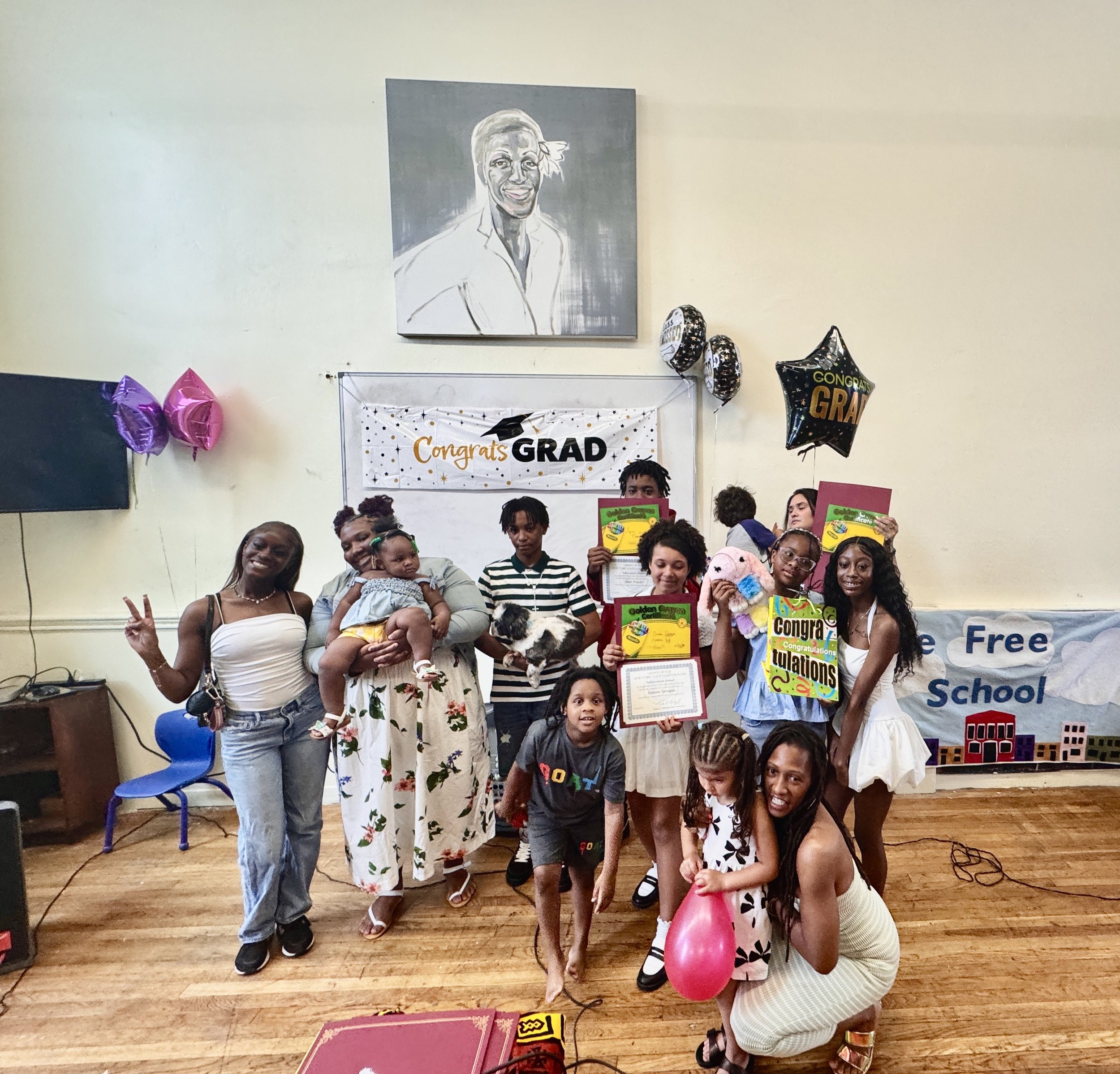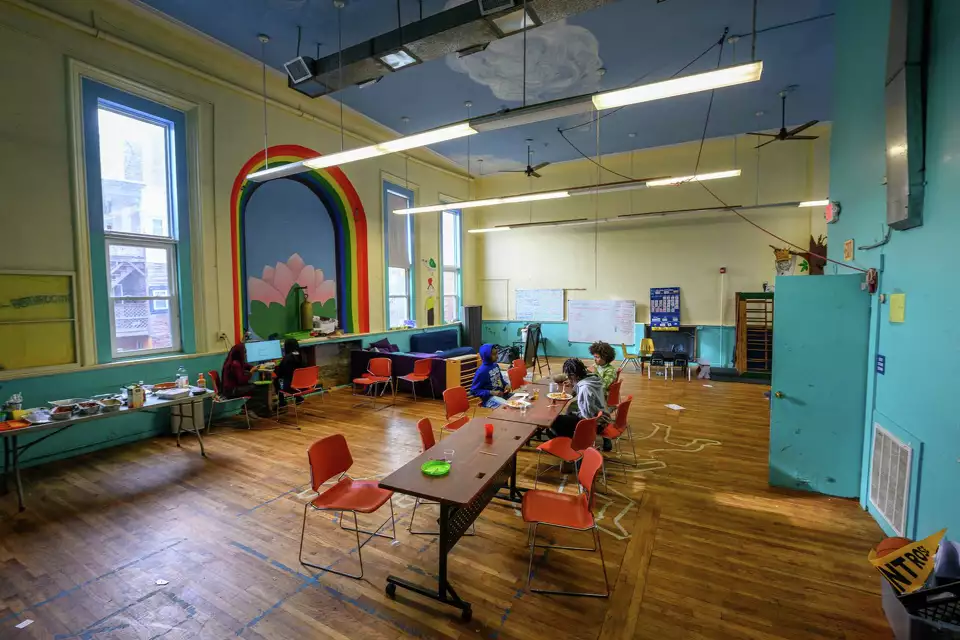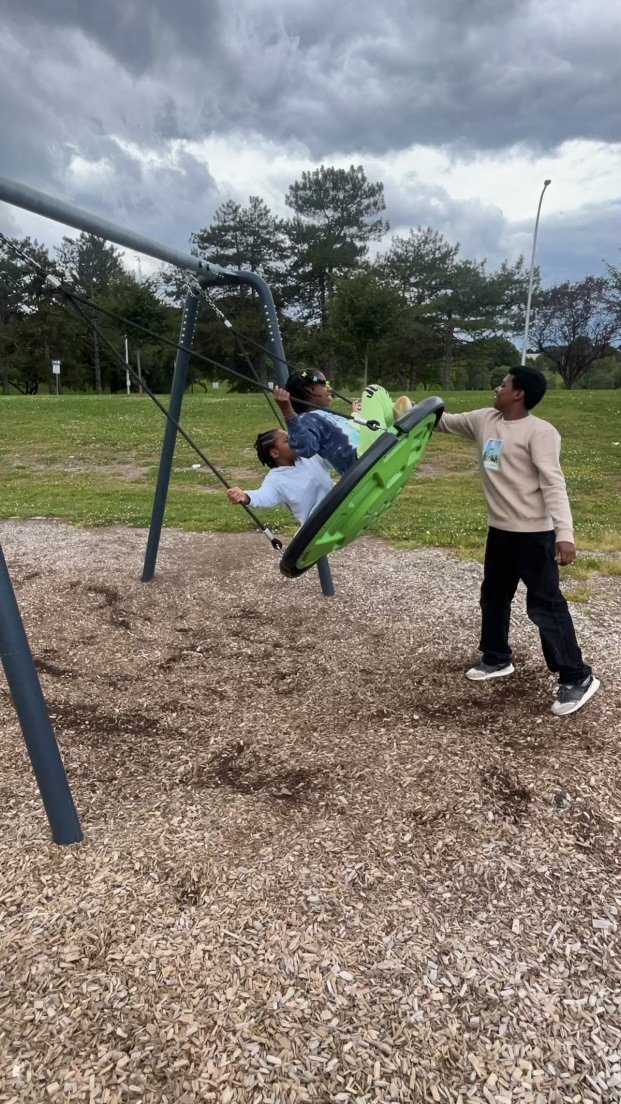
Daily Rhythm & Learning Environments
A Day at the Albany Free School
Rooted in Justice. Guided by Joy. Built for Childhood.
Our mixed-age environment encourages mentorship, leadership, and connection. Whether students are exploring letters in sand or debating current events, their questions help shape the day. We honor each child’s pace and purpose, offering space to think, play, and practice new ways of being together in the world.
At the Albany Free School, each day is designed to nurture curiosity, confidence, and community. Students are seen, supported, and given room to grow into themselves. From Pre-K through eighth grade, our learning rhythm balances structure with flexibility, academic challenge with emotional care, and voice with accountability.
PreK-2: Roots of Belonging and Wonder
Morning begins gently in calming classrooms filled with light, music, and sensory tools. Children settle in with puzzles, picture books, or quiet play. Daily morning circles bring students together through song, movement, and affirmations that ground them in safety and joy.
Throughout the day, learning unfolds through stories, art, and nature. Read-alouds spark empathy and imagination. Writing is introduced through drawing, storytelling, and playful phonics. Math emerges in cooking, block play, and neighborhood walks. Thematic projects like “Homes and Habitats” integrate science and social studies. Time outdoors and sensory supports help children feel at ease, expressive, and engaged.
Grades 3-5: Branches of Inquiry and Voice
As students grow, so does their sense of identity and agency. The day often starts with journaling or classroom circles where students share thoughts or reflect on questions tied to fairness, belonging, or community.
Academic blocks are grounded in exploration. Students read folktales, biographies, and oral histories, then write zines, speeches, or stories that connect to their own experiences. Math becomes a problem-solving tool, used to plan events or analyze patterns in the world around them. Project-based learning encourages teamwork and research. Creative time and restorative circles help students build emotional skills, celebrate progress, and care for one another.
Grades 6-8: Canopies of Leadership and Liberation
Middle school students are invited to lead. Mornings begin with forums that might include peer presentations, dialogue on current issues, or guided mindfulness. Students explore their values and develop the tools to express them clearly and responsibly.
Literacy focuses on writing with purpose. Students analyze songs, essays, news, and fiction, then create op-eds, personal narratives, and campaign materials. Math is applied to real-world challenges and design thinking. Thematic units explore justice and community, often leading to fieldwork or civic projects. Electives support deeper inquiry in media, movement, or organizing. Advisory groups meet daily to reflect, recalibrate, and prepare for what’s next.
General Daily Rhythm (K–8)
Rooted in Justice. Structured in Love. Flexible for Development.
-
8:00-8:30 AM
Segment
Arrival, Breakfast & Grounding
Purpose
Soft start: students ease in with self-directed activities (journaling, puzzles, music, sensory stations). Morning meeting with affirmations and calendar follows.
Root Values
Community Care, Joy is Justice, Identity & Belonging
-
8:30-9:30 AM
Segment
Literacy Block
Purpose
Reading, writing, discussion—using culturally relevant texts and student voice as a central text.
Root Values
Liberation through Education, Cultural Memory, Memory & Storytelling
-
9:30-10:15 AM
Segment
Math in Action
Purpose
Conceptual math, real-world applications, peer dialogue, visual and physical tools.
Root Values
Scholarship is for the People, Interdependence, Power & Justice
-
10:15–10:30 AM
Segment
Snack & Free Play / Movement Break
Purpose
Indoor or outdoor reset time. Encourages body awareness and social skills.
Root Values
Joy is Justice, Every Child is a Seed of Change
-
10:30–11:30 AM
Segment
Integrated Theme-Based Learning (Social Studies / Science / Project Work)
Purpose
Interdisciplinary work rooted in quarterly themes. Research, experimentation, community learning, fieldwork.
Root Values
Cultural Memory, Resistance & Resilience, Place & Land
-
11:30 AM–12:15 PM
Segment
Lunch & Community Time
Purpose
Shared meals in mixed-grade “families” or classrooms. Sometimes includes music or storytelling.
Root Values
Community Care, Interdependence, Joy
-
12:15–1:00 PM
Segment
Art, Music, or Movement
Purpose
Rotating creative expression blocks: music, dance, visual arts, or physical education.
Root Values
Joy is Justice, Memory & Storytelling, Identity & Belonging
-
1:00–1:45 PM
Segment
Restorative Circles / Advisory
Purpose
Dialogue-based space for reflection, connection, conflict resolution, and affirming students’ experiences.
Root Values
Community Care Over Control, Power & Justice, Belonging
-
1:45–2:30 PM
Segment
Afternoon Workshop / Applied Learning
Purpose
Labs, hands-on projects, or choice-based enrichment (gardening, tech, theater, student-led clubs).
Root Values
Every Child is a Seed of Change, Resistance, Joy
-
2:30–3:00 PM
Segment
Closing Reflection & Dismissal
Purpose
Exit ticket, group share-out, mindfulness, or appreciation circle.
Root Values
Liberation Through Education, Legacy & Solidarity
Notes for PreK:
PreK follows a similar rhythm with more emphasis on sensory play, flexible timing, longer rest/quiet time, and daily family-style story circles. Core segments remain: grounding, literacy, exploration, creative expression, and community care.
Learning Environment Model
Designed for Justice-Rooted, Student-Centered Practice
-
Mixed-Age Pods:
For classes, electives and lunch (e.g. 1–2, 3–5, 6–8) to build mentorship and community.
-
Flexible Seating:
Cushions, floor spots, standing desks, sensory spaces.
-
Student Voice Walls:
Where student questions, dreams, and declarations are posted.
-
Community Corner:
Featuring local elders, oral histories, news clippings, and neighborhood maps.
-
Healing & Quiet Zones:
Nooks for regulation and self-directed calming.
-
Outdoor Learning:
Daily access to nature, even brief “sky breaks” or sidewalk walks.
-
Culturally Reflective Materials:
Books, art, manipulatives representing Black, Indigenous, and diasporic cultures.
-
Student-Created Visuals:
Anchor charts, murals, and documentation displays made with student input.
Daily Rhythm & Learning Environment Comparison: PreK–8
[Practice of Learning]
-
Arrival & Grounding
PreK-2
Soft start with sensory play, music, storybook zones
Grades 3-5
Journaling, social check-ins, affirmations
Grades 6-8
Current events dialogue, mindfulness, or student-led warm-ups
-
Literacy Block
PreK-2
Phonics, read-alouds, story retelling with art/play
Grades 3-5
Culturally relevant novels, writing workshops
Grades 6-8
Critical literacy, debates, genre studies
-
Math Block
PreK-2
Manipulatives, songs, stories with numbers
Grades 3-5
Games, group problem-solving, real-world math
Grades 6-8
Project-based math, budgeting, data analysis
-
Snack / Movement
PreK-2
Extended outdoor time, dancing, rest mats
Grades 3-5
Active break: playground or indoor circuits
Grades 6-8
Self-directed break with regulation tools or music
-
Theme-Based Learning
PreK-2
Exploration via nature walks, block play, classroom experiments
Grades 3-5
Research-based projects with group work
Grades 6-8
Independent and collaborative anchor projects connected to social issues
-
Lunch & Community
PreK-2
Family-style eating, storytelling with staff
Grades 3-5
Table prompts, peer discussion, music
Grades 6-8
Mixed-grade tables, journaling, music, quiet time option
-
Creative Time
PreK-2
Art, dramatic play, music circles
Grades 3-5
Theater, painting, drumming, coding intro
Grades 6-8
Media arts, spoken word, film, movement electives
-
Circle Time / Advisory
PreK-2
Story circles, feelings chart, shared rituals
Grades 3-5
Restorative circles, role-play, identity mapping
Grades 6-8
Peer mediation, organizing forums, reflective journaling
-
Applied Learning
PreK-2
Messy play, exploration centers
Grades 3-5
Labs, gardening, tool use, mapping
Grades 6-8
Studio time, peer critique, civic engagement projects
-
Closing & Reflection
PreK-2
Song, affirmations, story, gratitude
Grades 3-5
Group share-out, appreciations, visual journaling
Grades 6-8
Exit surveys, student-led announcements, journaling
Learning Environment Snapsot
[Evidence of Learning]
-
Seating
PreK-2
Cushions, floor mats, cozy corners
Grades 3-5
Group tables, flexible desk zones
Grades 6-8
Modular desks, standing + lounge options
-
Sensory Zones
PreK-2
Water tables, soft lighting
Grades 3-5
Regulation corners with posters
Grades 6-8
Calm-down stations with journaling options
-
Student Voice
PreK-2
Visuals of class rules made together
Grades 3-5
“I wonder…” wall, co-created charts
Grades 6-8
Planning boards, public idea spaces
-
Community Displays
PreK-2
Family photos, name murals
Grades 3-5
Classroom vision boards
Grades 6-8
Timeline of activism, student exhibits
-
Outdoor Learning
PreK-2
Daily exploration, garden visits
Grades 3-5
Weekly field-based inquiry
Gradese 6-8
Project fieldwork, “independent” site visits
-
Tech Use
PreK-2
Minimal, story-based apps
Grades 3-5
Research stations, creative tools
Grades 6-8
Media production, research and editing





